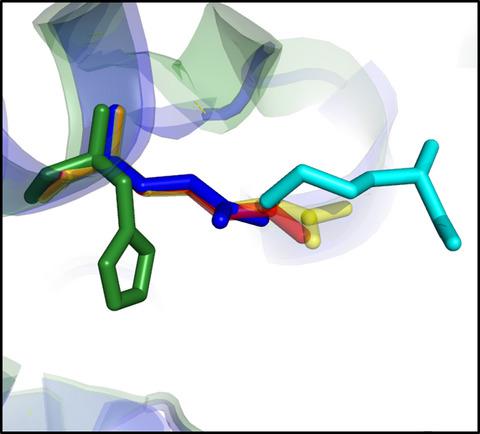Our official English website, www.x-mol.net, welcomes your
feedback! (Note: you will need to create a separate account there.)
Identification of two dihydrodipicolinate synthase isoforms from Pseudomonas aeruginosa that differ in allosteric regulation.
The FEBS Journal ( IF 5.5 ) Pub Date : 2019-08-05 , DOI: 10.1111/febs.15014 Rachael E Impey 1 , Santosh Panjikar 2, 3 , Cody J Hall 1 , Lucy J Bock 4 , J Mark Sutton 4 , Matthew A Perugini 1 , Tatiana P Soares da Costa 1
The FEBS Journal ( IF 5.5 ) Pub Date : 2019-08-05 , DOI: 10.1111/febs.15014 Rachael E Impey 1 , Santosh Panjikar 2, 3 , Cody J Hall 1 , Lucy J Bock 4 , J Mark Sutton 4 , Matthew A Perugini 1 , Tatiana P Soares da Costa 1
Affiliation

|
Pseudomonas aeruginosa is one of the leading causes of nosocomial infections, accounting for 10% of all hospital-acquired infections. Current antibiotics against P. aeruginosa are becoming increasingly ineffective due to the exponential rise in drug resistance. Thus, there is an urgent need to validate and characterize novel drug targets to guide the development of new classes of antibiotics against this pathogen. One such target is the diaminopimelate (DAP) pathway, which is responsible for the biosynthesis of bacterial cell wall and protein building blocks, namely meso-DAP and lysine. The rate-limiting step of this pathway is catalysed by the enzyme dihydrodipicolinate synthase (DHDPS), typically encoded for in bacteria by a single dapA gene. Here, we show that P. aeruginosa encodes two functional DHDPS enzymes, PaDHDPS1 and PaDHDPS2. Although these isoforms have similar catalytic activities (kcat = 29 s-1 and 44 s-1 for PaDHDPS1 and PaDHDPS2, respectively), they are differentially allosterically regulated by lysine, with only PaDHDPS2 showing inhibition by the end product of the DAP pathway (IC50 = 130 μm). The differences in allostery are attributed to a single amino acid difference in the allosteric binding pocket at position 56. This is the first example of a bacterium that contains multiple bona fide DHDPS enzymes, which differ in allosteric regulation. We speculate that the presence of the two isoforms allows an increase in the metabolic flux through the DAP pathway when required in this clinically important pathogen. DATABASES: PDB ID: 6P90.
中文翻译:

鉴定铜绿假单胞菌的两种二氢二吡啶甲酸合酶同工型,它们的变构调节不同。
铜绿假单胞菌是医院感染的主要原因之一,占所有医院获得性感染的10%。由于耐药性的指数上升,当前针对铜绿假单胞菌的抗生素变得越来越无效。因此,迫切需要验证和表征新颖的药物靶标,以指导针对该病原体的新型抗生素的开发。这样的靶标之一是二氨基庚二酸酯(DAP)途径,其负责细菌细胞壁和蛋白质构件(即内消旋DAP和赖氨酸)的生物合成。该途径的限速步骤由二氢双吡啶甲酸合酶(DHDPS)催化,该酶通常在细菌中由单个dapA基因编码。在这里,我们显示铜绿假单胞菌编码两种功能DHDPS酶,PaDHDPS1和PaDHDPS2。尽管这些同工型具有相似的催化活性(PaDHDPS1和PaDHDPS2的kcat分别为29 s-1和44 s-1),但它们受赖氨酸变构调控,只有PaDHDPS2受到DAP途径终产物的抑制(IC50 = 130μm)。变构的差异归因于56位变构结合口袋中的单个氨基酸差异。这是包含多种真正的DHDPS酶的细菌的第一个实例,所述酶在变构调节方面有所不同。我们推测这两种同工型的存在允许在这种临床上重要的病原体中需要时通过DAP途径的代谢通量增加。数据库:PDB ID:6P90。它们受到赖氨酸的差异构象调节,只有PaDHDPS2被DAP途径的终产物抑制(IC50 = 130μm)。变构的差异归因于56位变构结合口袋中的单个氨基酸差异。这是包含多种真正的DHDPS酶的细菌的第一个实例,所述酶在变构调节方面有所不同。我们推测这两种同工型的存在允许在这种临床上重要的病原体中需要时通过DAP途径的代谢通量增加。数据库:PDB ID:6P90。它们受到赖氨酸的差异构象调节,只有PaDHDPS2被DAP途径的终产物抑制(IC50 = 130μm)。变构的差异归因于56位变构结合口袋中的单个氨基酸差异。这是包含多种真正的DHDPS酶的细菌的第一个实例,所述酶在变构调节方面有所不同。我们推测这两种同工型的存在允许在这种临床上重要的病原体中需要时通过DAP途径的代谢通量增加。数据库:PDB ID:6P90。变构的差异归因于56位变构结合口袋中的单个氨基酸差异。这是包含多种真正的DHDPS酶的细菌的第一个实例,所述酶在变构调节方面有所不同。我们推测这两种同工型的存在允许在这种临床上重要的病原体中需要时通过DAP途径的代谢通量增加。数据库:PDB ID:6P90。变构的差异归因于56位变构结合口袋中的单个氨基酸差异。这是包含多种真正的DHDPS酶的细菌的第一个实例,所述酶在变构调节方面有所不同。我们推测这两种同工型的存在允许在这种临床上重要的病原体中需要时通过DAP途径的代谢通量增加。数据库:PDB ID:6P90。
更新日期:2020-01-21
中文翻译:

鉴定铜绿假单胞菌的两种二氢二吡啶甲酸合酶同工型,它们的变构调节不同。
铜绿假单胞菌是医院感染的主要原因之一,占所有医院获得性感染的10%。由于耐药性的指数上升,当前针对铜绿假单胞菌的抗生素变得越来越无效。因此,迫切需要验证和表征新颖的药物靶标,以指导针对该病原体的新型抗生素的开发。这样的靶标之一是二氨基庚二酸酯(DAP)途径,其负责细菌细胞壁和蛋白质构件(即内消旋DAP和赖氨酸)的生物合成。该途径的限速步骤由二氢双吡啶甲酸合酶(DHDPS)催化,该酶通常在细菌中由单个dapA基因编码。在这里,我们显示铜绿假单胞菌编码两种功能DHDPS酶,PaDHDPS1和PaDHDPS2。尽管这些同工型具有相似的催化活性(PaDHDPS1和PaDHDPS2的kcat分别为29 s-1和44 s-1),但它们受赖氨酸变构调控,只有PaDHDPS2受到DAP途径终产物的抑制(IC50 = 130μm)。变构的差异归因于56位变构结合口袋中的单个氨基酸差异。这是包含多种真正的DHDPS酶的细菌的第一个实例,所述酶在变构调节方面有所不同。我们推测这两种同工型的存在允许在这种临床上重要的病原体中需要时通过DAP途径的代谢通量增加。数据库:PDB ID:6P90。它们受到赖氨酸的差异构象调节,只有PaDHDPS2被DAP途径的终产物抑制(IC50 = 130μm)。变构的差异归因于56位变构结合口袋中的单个氨基酸差异。这是包含多种真正的DHDPS酶的细菌的第一个实例,所述酶在变构调节方面有所不同。我们推测这两种同工型的存在允许在这种临床上重要的病原体中需要时通过DAP途径的代谢通量增加。数据库:PDB ID:6P90。它们受到赖氨酸的差异构象调节,只有PaDHDPS2被DAP途径的终产物抑制(IC50 = 130μm)。变构的差异归因于56位变构结合口袋中的单个氨基酸差异。这是包含多种真正的DHDPS酶的细菌的第一个实例,所述酶在变构调节方面有所不同。我们推测这两种同工型的存在允许在这种临床上重要的病原体中需要时通过DAP途径的代谢通量增加。数据库:PDB ID:6P90。变构的差异归因于56位变构结合口袋中的单个氨基酸差异。这是包含多种真正的DHDPS酶的细菌的第一个实例,所述酶在变构调节方面有所不同。我们推测这两种同工型的存在允许在这种临床上重要的病原体中需要时通过DAP途径的代谢通量增加。数据库:PDB ID:6P90。变构的差异归因于56位变构结合口袋中的单个氨基酸差异。这是包含多种真正的DHDPS酶的细菌的第一个实例,所述酶在变构调节方面有所不同。我们推测这两种同工型的存在允许在这种临床上重要的病原体中需要时通过DAP途径的代谢通量增加。数据库:PDB ID:6P90。







































 京公网安备 11010802027423号
京公网安备 11010802027423号